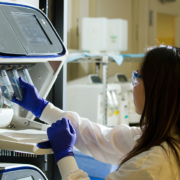Climate change is a health industry issue, too
Climate change is a health industry issue, too
By Jon Bigelow
Globally, June was the hottest month on record, according to the University of Maine — and at this writing, it appears certain July will break that record. The Southwest broiled during a string of 110-degree days; water temperatures off the Florida coast touched 97 degrees. Smoke from wildfires polluted the air in Midwest and Mid-Atlantic states. Drenching rains and overflowing rivers washed away critical roads in Vermont.
The extreme weather events we’ve all been watching are reminders of the myriad implications of climate change for human health, food security, the economy, geopolitics, biodiversity, and how we live each day. They demand an all-hands-on-deck approach to reducing the causes of global warming. Investors increasingly realize this, as do top leaders at a growing number of companies. This collective effort involves all industries; let’s focus here on the hospital and pharmaceutical sectors.
8.5 percent of U.S. emissions
Arup, an engineering consultancy in Boston, calculates that healthcare systems are responsible for 4.4 percent of global carbon dioxide emissions — more than the aviation or shipping sectors. Even more striking, Matthew Eckelman of Northeastern University and colleagues found that the healthcare sector (including hospitals, physician services, pharmaceuticals, and other areas) is responsible for about 8.5 percent of all greenhouse emissions in the United States.
Precision in such calculations is impossible, but the bottom line is clear: healthcare and pharma contribute to the problem. Finding solutions is a key challenge we can’t ignore.
Hospitals
Eckelman and colleagues estimate that about 35 percent of the healthcare sector’s greenhouse emissions are attributable to hospitals. Predictably, one factor is the use of fossil fuels; after all, hospital facilities are running around the clock. As for any industry, strategies here would focus on greater energy efficiency when designing, building, or renovating facilities, including everything from choosing heating and cooling systems, to relying on renewable energy sources, to deciding where to locate the kitchen in relation to patient rooms, to insulating pipes and valves.
More specific to hospitals is the production and purchasing of goods used to deliver care. Consider for a moment the amount of waste inherent in the way hospitals and other care facilities package, distribute, and use syringes, pipettes, gloves, and innumerable other items. Although there are clinical reasons to package supplies or medication for single use, in small units, and/or in specialized containers, are there less plastic-intensive options or better ways to recycle?
A less visible issue is the impact of emissions from inhaled anesthetics. The choice of agent makes a difference; for example, desflurane, used widely in American hospitals, produces profound levels of carbon dioxide, whereas sevoflurane is less damaging.
The Department of Health and Human Services is gathering pledges from leading hospital systems to cut emissions by 50 percent by 2030. The Center for Medicare and Medicaid Services last year asked for comments on reducing the delivery of health care’s impact on climate change, and as the largest payer in the healthcare system it has the clout to influence or regulate in this area. One would hope that financial self-interest would also push hospital systems forward; greater efficiency saves money.
On the pharma side
The emissions impact of pharmaceutical companies is smaller than that of hospital systems, yet a McMaster University study calculated it is greater, in relation to revenue, than that of the automotive industry. There are opportunities here to increase efficiency of operations, reduce waste, derive more energy from renewables, and similar strategies.
Continuous manufacturing techniques (moving from batch manufacturing to a single, continuous production line) may increase efficiency and reduce wastage. At manufacturing facilities anywhere, reducing the spillage of antibiotics or other newly-produced drugs into the surrounding ecosystems would reduce pollution and save money.
And there are opportunities to more aggressively address specific problems, for example by reducing the use of hydrofluorocarbons in metered-dose inhalers or developing heat-stable products that are more resilient as they travel through the supply chain.
Which raises the point that the greatest portion of pharmaceutical industry emissions is attributable to vendors in the long supply chains. Pharma can press these suppliers to reduce emissions from their own manufacturing processes, but this may have limited impact when so many suppliers are in China and India. Side benefits of the current trend toward moving manufacturing of drug ingredients back to the United States would be greater ability to challenge suppliers to limit emissions, as well as less energy spent in shipping from afar.
One other problem to note: On a warming planet, the patterns in which infectious diseases spread are changing. Mosquitos, ticks, or other insect vectors thrive in broader geographic regions; water-borne diseases are exacerbated by flooding, storm surges, and contaminated runoff, and zoonotic diseases spread more easily.
Funding for research and development of new antimicrobials has been too low for too long, partly due to the relative lack of financial incentives for companies to invest in development of drugs to be used for short courses under restrictions. Measures to increase the incentives for antimicrobial R&D spending, for example through a subscription-based model similar to that in the long-proposed PASTEUR Act, could help.
Are we up to this moment?
Probably each issue touched on in this brief overview is worthy of its own column. The goal today is to remind us that even within our own sector of the economy, there is an urgent need for action.
The federal government is providing financial incentives through last year’s Inflation Reduction Act. And while there’s always the risk of “greenwashing,” more pharma companies and hospital systems are setting goals and taking specific steps to reduce their emissions.
Still, more action and creative thinking is needed. In recent decades, innovative approaches have shifted where mechanical ventilation is delivered, moved patients from the ICU to step-down units, and simplified delivery of many medications. There is no one easy answer to the problem of climate change, but where there is an overlap of financial incentives and societal pressure, progress can come rapidly. Let’s hope the hospital and pharmaceutical sectors are up to this moment.
| Jon Bigelow is president, Thayer Pond Solutions. He is the former CEO of KnowledgePoint360 Group. |












